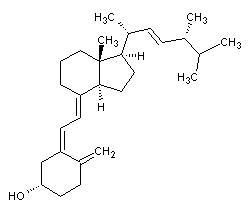
Structural formula
| Business number | 0138 |
|---|---|
| Molecular formula | C28H44O |
| Molecular weight | 396.66 |
| label |
Vitamin D2, Butyrosin, calciferol, Calciferol, Ercalciol, Ergosterol irradiated, Irradiated ergosterol, Vitamin D2, Nutrition supplements |
Numbering system
CAS number:50-14-6
MDL number:MFCD00166988
EINECS number:200-014-9
RTECS number:KE1050000
BRN number:1916682
PubChem number:24894344
Physical property data
1. Properties: White needle-like crystals or crystalline powder, odorless and tasteless. Reduced activity when exposed to oxygen or light
2. Density (g/mL, 25/4℃): Undetermined
3. Relative vapor density (g/mL, air=1) : Undetermined
4. Melting point (ºC): 115-118 (decomposition)
5. Boiling point (ºC, normal pressure): Undetermined
6 . Boiling point (ºC, 5.2 kPa): Not determined
7. Refractive index: Not determined
8. Flash point (ºC): Not determined
9 . Specific rotation (º): 82 º (c=3, in acetone 25 ºC)
10. Autoignition point or ignition temperature (ºC): Undetermined
11. Vapor pressure (kPa, 25 ºC): Not determined
12. Saturated vapor pressure (kPa, 60 ºC): Not determined
13. Heat of combustion (KJ/mol): Not determined Determined
14. Critical temperature (ºC): Undetermined
15. Critical pressure (KPa): Undetermined
16. Oil and water (octanol/water ) Log value of distribution coefficient: Undetermined
17. Explosion upper limit (%, V/V): Undetermined
18. Explosion lower limit (%, V/V): Undetermined Confirm
19. Solubility: Easily soluble in ethanol (1:2), ether (1:2), acetone (1:10) and chloroform (1:0.7), insoluble in water (H2O: 200 mg/mL, clear to hazy);Easily soluble in chloroform. Easily soluble in ethanol, acetone or ether, slightly soluble in vegetable oil.
Toxicological data
Guinea pig oralLD50:40 mg/kg.
Ecological data
None
Molecular structure data
None
Compute chemical data
1. Reference value for hydrophobic parameter calculation (XlogP): 7.4
2. Number of hydrogen bond donors: 1
3. Number of hydrogen bond acceptors: 1
4. Number of rotatable chemical bonds: 5
5. Number of tautomers:
6. Topological molecular polar surface area (TPSA): 20.2
7. Number of heavy atoms: 29
8. Surface charge: 0
9. Complexity: 678
10. Number of isotope atoms: 0
11. Determine the number of atomic stereocenters: 6
12. Uncertain number of atomic stereocenters: 0
13. Determine the number of chemical bond stereocenters Number: 3
14. Number of uncertain chemical bond stereocenters: 0
15. Number of covalent bond units: 1
Properties and stability
None
Storage method
This product should be sealed with argon gas and stored in a dry place at 4°C away from light.
Synthesis method
1. Dissolve ergosterol in ethanol, open the ring under UV irradiation, concentrate the reaction solution under reduced pressure, freeze and filter. Filtrate the liquid nitrogen and concentrate to dryness under reduced pressure to obtain vitamin D2 crude oil, which is refined to obtain the finished product.
2. Vitamin D2 naturally exists in liver, milk and egg yolk. In industry, ergocalciferol, which cannot be absorbed by the human body, is often extracted from vegetable oil or yeast. , dissolved in chloroform or cyclohexane, converted into vitamin D2 by ultraviolet irradiation.
3.Ergosterol isolated from beer yeast, shiitake mushrooms, etc., Dissolve in solvents such as chloroform, ether or cyclohexane, add it to a flask made of quartz glass, and obtain it by irradiating it with ultraviolet light.
Purpose
1. Mainly used for the prevention and treatment of rickets; osteomalacia; infantile tetany, etc. 2.Vitamin D2 can maintain the normal metabolism of calcium and phosphorus, promote the absorption of calcium and phosphorus in the small intestine, maintain the normal ratio of calcium and phosphorus in the blood, and turn calcium into phosphoric acid Calcium is deposited into bones, flesh and tissues. Insufficient intake can lead to rickets, osteomalacia, etc. Our country stipulates that it can be used to fortify margarine, the usage amount is 125-156μg/kg; the usage amount in fortified dairy products is 63-125μg/kg; the usage amount in fortified infant food is 50-100μg/kg; in fortified milk and The usage amount in milk drinks is 10-40μg/kg; the maximum usage amount in fortified solid drinks and ice cream is 10-20μg/kg. It is usually used together with vitamin A in food. 3.Used in cosmetics, it can prevent dry skin, eczema, and abnormal nails and hair.

 微信扫一扫打赏
微信扫一扫打赏

